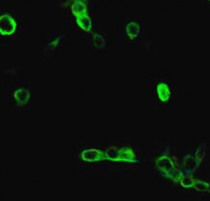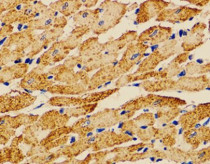ARG40752
anti-ATP5B antibody
anti-ATP5B antibody for ICC/IF,IHC-Formalin-fixed paraffin-embedded sections,Western blot and Human,Mouse,Rat
Overview
| Product Description | Rabbit Polyclonal antibody recognizes ATP5B |
|---|---|
| Tested Reactivity | Hu, Ms, Rat |
| Tested Application | ICC/IF, IHC-P, WB |
| Host | Rabbit |
| Clonality | Polyclonal |
| Isotype | IgG |
| Target Name | ATP5B |
| Antigen Species | Human |
| Immunogen | Recombinant fusion protein corresponding to aa. 230-529 of Human ATP5B (NP_001677.2). |
| Conjugation | Un-conjugated |
| Alternate Names | ATPMB; ATPSB; EC 3.6.3.14; HEL-S-271; ATP synthase subunit beta, mitochondrial |
Application Instructions
| Application Suggestion |
|
||||||||
|---|---|---|---|---|---|---|---|---|---|
| Application Note | * The dilutions indicate recommended starting dilutions and the optimal dilutions or concentrations should be determined by the scientist. | ||||||||
| Positive Control | HepG2 | ||||||||
| Observed Size | 56 kDa |
Properties
| Form | Liquid |
|---|---|
| Purification | Affinity purified. |
| Buffer | PBS (pH 7.3), 0.02% Sodium azide and 50% Glycerol. |
| Preservative | 0.02% Sodium azide |
| Stabilizer | 50% Glycerol |
| Storage Instruction | For continuous use, store undiluted antibody at 2-8°C for up to a week. For long-term storage, aliquot and store at -20°C. Storage in frost free freezers is not recommended. Avoid repeated freeze/thaw cycles. Suggest spin the vial prior to opening. The antibody solution should be gently mixed before use. |
| Note | For laboratory research only, not for drug, diagnostic or other use. |
Bioinformation
| Database Links | |
|---|---|
| Gene Symbol | ATP5B |
| Gene Full Name | ATP synthase, H+ transporting, mitochondrial F1 complex, beta polypeptide |
| Background | This gene encodes a subunit of mitochondrial ATP synthase. Mitochondrial ATP synthase catalyzes ATP synthesis, utilizing an electrochemical gradient of protons across the inner membrane during oxidative phosphorylation. ATP synthase is composed of two linked multi-subunit complexes: the soluble catalytic core, F1, and the membrane-spanning component, Fo, comprising the proton channel. The catalytic portion of mitochondrial ATP synthase consists of 5 different subunits (alpha, beta, gamma, delta, and epsilon) assembled with a stoichiometry of 3 alpha, 3 beta, and a single representative of the other 3. The proton channel consists of three main subunits (a, b, c). This gene encodes the beta subunit of the catalytic core. [provided by RefSeq, Jul 2008] |
| Function | Mitochondrial membrane ATP synthase (F(1)F(0) ATP synthase or Complex V) produces ATP from ADP in the presence of a proton gradient across the membrane which is generated by electron transport complexes of the respiratory chain. F-type ATPases consist of two structural domains, F(1) - containing the extramembraneous catalytic core, and F(0) - containing the membrane proton channel, linked together by a central stalk and a peripheral stalk. During catalysis, ATP synthesis in the catalytic domain of F(1) is coupled via a rotary mechanism of the central stalk subunits to proton translocation. Subunits alpha and beta form the catalytic core in F(1). Rotation of the central stalk against the surrounding alpha(3)beta(3) subunits leads to hydrolysis of ATP in three separate catalytic sites on the beta subunits. [UniProt] |
| Cellular Localization | Mitochondrion inner membrane; Peripheral membrane protein; Matrix side. [UniProt] |
| Calculated MW | 57 kDa |
Images (3) Click the Picture to Zoom In
-
ARG40752 anti-ATP5B antibody ICC/IF image
Immunofluorescence: NIH/3T3 cells stained with ARG40752 anti-ATP5B antibody at 1:100 dilution.
-
ARG40752 anti-ATP5B antibody IHC-P image
Immunohistochemistry: Paraffin-embedded Mouse heart stained with ARG40752 anti-ATP5B antibody at1:100 dilution.
-
ARG40752 anti-ATP5B antibody WB image
Western blot: 25 µg of HepG2 cell lysate stained with ARG40752 anti-ATP5B antibody at 1:1000 dilution.








